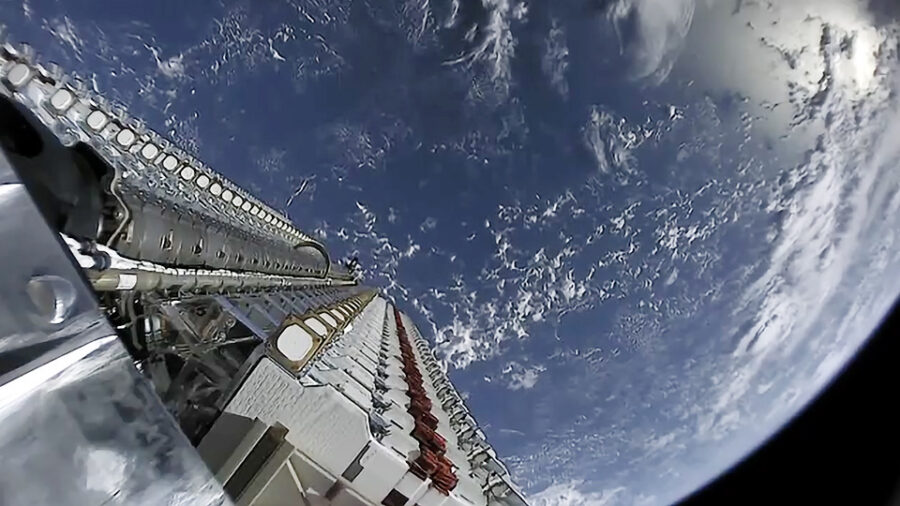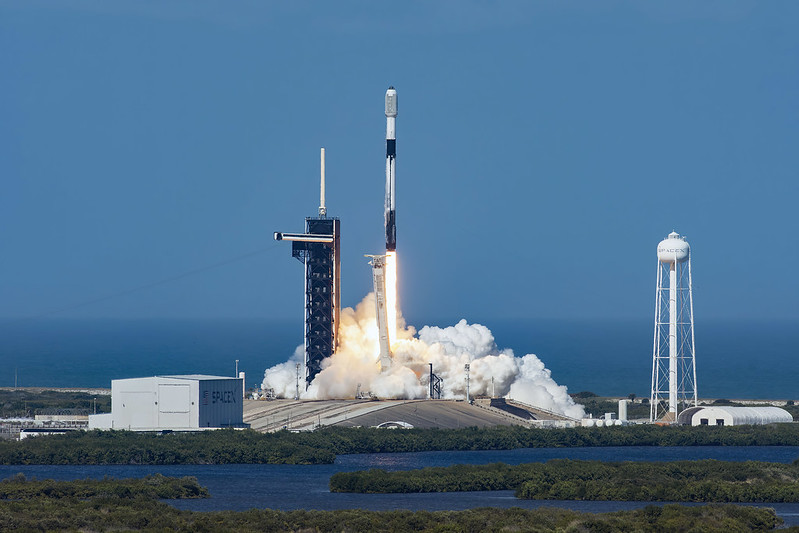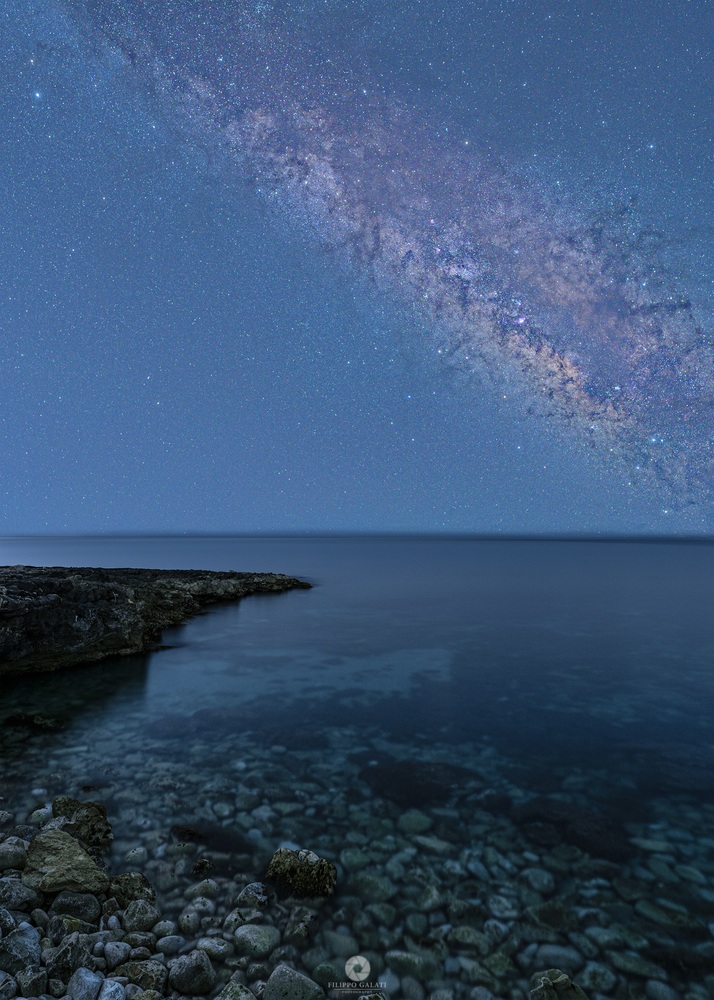A minor space storm took down much of the latest Starlink batch shortly after launch.

SpaceX
On February 3rd, a SpaceX Falcon 9 rocket launched out of the Kennedy Space Center in Florida with Starlink Group 4-7. The launch, part of a routine addition to SpaceX's Starlink satellite network, went off without a hitch. But it soon became clear that something was amiss.

SpaceX
What the worldwide satellite-tracking community picked up on was the initial Two-Line Elements (TLEs) published for the launch by U.S. Combined Space Operations Center Space-Track. Instead of the full complement of 49 satellites plus the usual associated hardware debris, the site listed only four (COSPAR IDs 2022-010A-D). What’s more, the perigees for this initial quintet were all extremely low, around 190 kilometers (120 miles). Reentry predictions soon started popping up on the site shortly after publication.
SpaceX confirmed those suspicions on February 8th, when it released a statement on the loss of up to 40 satellites from the batch. The statement outlined a nominal deployment into an initial 210-kilometer orbit before calamity struck.
Space Weather Wipeout
The culprit was space weather: The Sun released a magnetized bubble of solar plasma known as a coronal mass ejection that struck the Earth environment right around the time of launch. That sparked a minor G1-class geomagnetic storm during the deployment phase for the Starlink satellites.
SpaceX normally releases the Starlinks into a lower initial orbit before boosting them to a higher operational altitude. This technique enables satellites to de-orbit more quickly if they should fail post-deployment checks. But when the geomagnetic storm hit, it caused Earth's upper atmosphere to puff out, and that dramatically increased the drag on the satellites to more than 50% over the normal expected load.

NOAA / SWPC
“Space weather affect satellites differently, depending upon where they orbit Earth,” says space weather physicist Tamitha Skov (The Aerospace Corporation). “For satellites like Starlink in low-Earth Orbit, solar storms are the phenomena that affect them the most dramatically. This is because during a solar storm, the storm’s energy sometimes can get past the Earth’s magnetic shield. When that happens all of the energy gets pumped into the near-Earth system and gets dumped into the Earth’s upper atmosphere.”
Reentries
SpaceX controllers reacted immediately to the unfolding events, placing the satellites in safe mode and angling them edge-on with respect to the atmosphere to minimize drag. Meanwhile, LeoLabs and U.S. Space Force’s 18th Space Control Squadron monitored the space weather situation.
However, the maneuvers weren't enough, and the company now expects to lose 40 of the 49 satellites from the batch. The impact of the loss is pretty minimal on the Starlink constellation overall: SpaceX has been keeping a breakneck launch pace as of late, with 1,888 working Starlink satellites in orbit and counting.
1/x
I can now say with some more certainty that this is one of the Starlink satellites from the unfortunate 3 Feb launch reentering the atmosphere.
I did some astrometry on the footage (taken from Añasco, Puerto Rico) for a very rough orbit fit. The aim was to get some (cont.) https://t.co/iaLyqndeVB— Dr Marco Langbroek 💉💉💉 x3 #vaccinate (@Marco_Langbroek) February 9, 2022
Already, Space-Track has listed six reentries from the failed batch of Starlinks. One was the source of a spectacular early morning reentry on February 7th over Puerto Rico:

Starlinks are about the size of a small coffee table, weighs in at 260 kilograms (570 pounds), small enough that debris from reentries aren't expected to survive to the ground.
Ultimately, the low-altitude release strategy worked as advertised in that it quickly eliminated the failed batch. But such events may become an increasing issue as more satellite constellations head to orbit, and as the Sun, in Solar Cycle 25, heads towards peak activity through 2023-2026. It’s worth noting that the coronal mass ejection and ensuing storm were mild events.
Community Reaction
“Many of us in the space weather field have been warning that this would happen at some point, especially as the new solar cycle ramps up,” says Skov. “Activity will continue to ramp up to solar maximum over the next five years so the potential for something like this to happen again in the near future should not be underestimated. As all good sailors know, if we are to bravely sail the seas of space, we should never underestimate the weather.”
Ironically, the plethora of satellites in low-Earth orbit might give space physicists the chance to study the upper ionosphere as it interacts with space weather events. However, for many fields of astronomy, the satellites pose a threat as their streaks across images hinder the search for near-Earth objects, cosmological studies, and other fields.
To address the growing threat, the International Astronomical Union has recently announced it's creating a new center to deal with the satellites' impact on astronomy — not just Starlink but others, too. The center will have multiple "hubs," to deal with multiple issues. One hub will create software to avoid and remove satellite trails in images taken by professional and extremely sensitive telescopes, for example, while another will advocate for policy changes to protect radio frequencies from interference, reduce space junk, and reduce overall impact on astronomy.
SpaceX isn't the only one creating such a network; OneWeb is busy launching its own set of satellites, with its 13th batch launching from the Guiana Space Center this afternoon. OneWeb expects its network to be providing broadband internet to users by the end of 2022.
It’s a brave new world and mitigating the impact of space weather on satellites will become an increasing issue to address in the years to come.
 1
1









Comments
Martian-Bachelor
February 23, 2022 at 5:34 pm
What are the odds the Sun will do us a big favor and take down the other 1,888 pieces of junk these morons have placed up there?
You must be logged in to post a comment.
You must be logged in to post a comment.